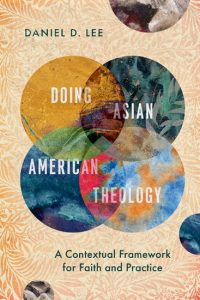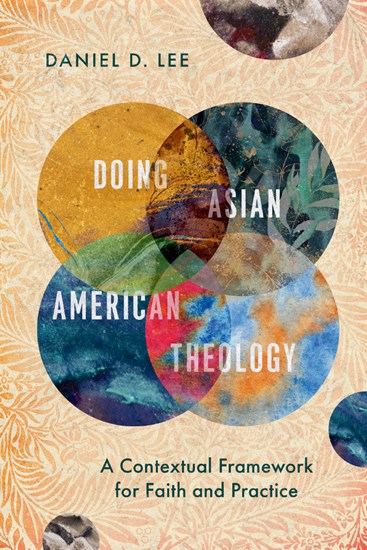Lee, Daniel D. Doing Asian American Theology: A Contextual Framework for Faith and Practice. Downers Grove, IL: InterVarsity Press, 2022, pp. 216, $24.00, paperback.
Daniel D. Lee is the Associate Professor of Theology and Asian American Studies, and also the academic dean for the Center for Asian American Theology and Ministry at Fuller Theological Seminary in Pasadena, California. Lee’s newest work, Doing Asian American Theology, presents his Asian American Quadrilateral (AAQ) as a heuristic tool to empower Asian Americans to live out Christian theology from their own contextuality/embodiment (p. 2). The elements of his AAQ are as follows: the first element is Asian heritage, which includes various inheritances from all across Asia, from the cultural to the religious (p. 68); the second element is the migration experience (p. 70); the third element is American culture, which includes American colonial histories in the Asian continent (p. 71); and the fourth and final element is racialization or, in other words, “the process of racial identity formation, navigating the Black/White binary, and the particular forms of discrimination the Asian Americans face as people of color” (p. 72). Lee’s AAQ constitutes the main thrust of the nine chapters in his book where he tries to theologically understand how God reveals himself to Asian American Christians and how Asian American Christians can, in turn, respond to God in their embodied selves: “Theological contextuality arises out of divine self-revelation of a covenantal God who enters history, making creation part of the divine being. Because Jesus is eternally Jewish, our present particularities matter as well” (p. 15). As such, Lee’s overarching point is that Asian American theology is both a task and calling that Asian American Christians ought to take seriously (p. 18).
As Lee proceeds with his AAQ as a framework for how an Asian American can do theology, one question that comes to mind is this: how do we even understand what “Asian American,” much less “Asian,” even means? With an umbrella term such as “Asian American,” Lee’s solution is to lean into Asian heritage and cultural archetypes in chapter four (the first chapter where Lee starts to expound on his AAQ in more detail). While there is much to say about the other parts of Lee’s AAQ, it seems to me that Asian heritage and cultural archetypes is the cornerstone of Lee’s AAQ, because it sets up a lot of what Lee does in the other three elements of his framework. Thus, the first part in particular of his AAQ perhaps presents the most thought-provoking element in Lee’s theological methodology. His examination of Asian heritage begins with a treatment of the geographic, temporal, and theoretical distance that Asian Americans have in relation to their own ancestral histories (pp. 78-79). Lee then proceeds to state, “A direct way to theologically engage Asian heritage is through a frame of interreligious dialogue” (pp. 78-79). This begs a few questions, though: what if this is irrelevant to some Asian American Christians? How relevant would this be for, say, Asian American adoptees or mixed-race Asian Americans?
To illustrate, one section in particular that stood out in that chapter was Lee’s analysis of Filipino heritage and cultural archetypes. As a Filipino American Christian, I took a great interest in this short but important section. Lee states, “The Philippine myths and indigenous spiritual beliefs are an important part of the Filipino cultural imagination” (p. 85). Now, it is important to mention that Lee wants to avoid cultural essentialism: “These elements should not be seen and handled as some eternal essence of ethnic culture” (p. 83). Yet, one cannot help but wonder this possibility: if a Filipino does not care much (much less know) about Philippine myths and indigenous spiritual beliefs, then is this Filipino less Filipino? If all a Filipino has ever known was growing up in church, then how important are these Philippine myths in light of the lived existence of the Filipino Christian? To give Lee the benefit of the doubt here, there is perhaps an element of truth in that there may perhaps be some trace of these indigenous beliefs in Filipino Christianity; but as to how important these cultural archetypes really are, is up for debate. To be sure, this is not only true with Filipino American Christianity, but also for other Asian American Christianities such as Chinese American and Korean American Christianity (both of which Lee highlights in chapter four).
Therefore, the student of theology and culture must ask whether or not culture can have the explanatory power to unite diverse people groups under an umbrella term such as “Asian American,” or perhaps divide diverse groups further. In other words, students must realize the inherent complexity at hand when discussing theology and culture. To Lee’s credit, though, he explains further in the chapter that there is a dialectic when it comes to culture: it is at once sinful (p. 100) and good if and only if God commandeers it to function as a witness (p. 101). And this, I think, is an important nuance that Lee makes close to the end of chapter four.
While chapter four had some weaknesses in terms of possible essentialism, chapter seven was Lee’s strongest as he aims to discuss racialization of Asian Americans and how Asian American Christians can resist “the lordless powers” of White supremacy (p. 166). He frames this resistance by primarily engaging with the problematic White/Black binary in contemporary discussion on race in America. Lee correctly highlights that part of how Asian Americans experience the process of racialization is being deemed invisible because of this racial binary; Asian Americans do not know, in other words, when or even how to engage in questions of race because they, because of this binary, do not know if it is their place to engage in such discussions (p. 164). Thus, Lee is right: the question at stake here is if Asian Americans can truly be deemed as American.
As such, Lee, with his undoubtably Barthian flavor, does a great job in his “lordless powers” section by beginning to form a very apt theological anthropology. In other words, Lee is saying that it is our duty as Asian American Christians to resist what he calls “White normativity” (the idea that whiteness is the norm in society) because, in this resistance, we are saying no to this demonic power (p. 166) while also becoming more human in the process (p. 168). Lee hence beautifully says that our embodied relationship with the incarnate God is simply to learn what it means to be more human (pp. 167-168).
In sum, Lee’s new book is undoubtedly a great contribution to Asian American theology because he envisions a grassroots theology through his own lens of “contextuality” (p. 20). In addition, Lee should be commended for bringing Asian heritage into the conversation when talking about Asian American theology because our heritage always plays a subtle role in all that we do theologically; there is thus an element of truth to Lee’s comment of there being a “cultural DNA” in an Asian American’s psyche. Overall, Lee really brings to the forefront the complexities of having an Asian American theology. Therefore, students of theology and culture (especially Asian American Christians) can highly benefit from engaging with Lee’s new work.
Kristoff Reese Grosfeld
Ph.D. Student, Princeton Theological Seminary





